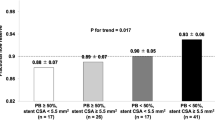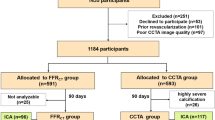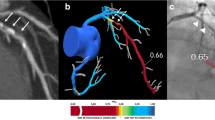Abstract
Objectives
To investigate the feasibility and prognostic implications of coronary CT angiography (CCTA) derived fractional flow reserve (FFRCT) in patients who have undergone stents implantation.
Methods
Firstly, the feasibility of FFRCT in stented vessels was validated. The diagnostic performance of FFRCT in identifying hemodynamically in-stent restenosis (ISR) in 33 patients with invasive FFR ≤ 0.88 as reference standard, intra-group correlation coefficient (ICC) between FFRCT and FFR was calculated. Secondly, prognostic value was assessed with 115 patients with serial CCTA scans after PCI. Stent characteristics (location, diameter, length, etc.), CCTA measurements (minimum lumen diameter [MLD], minimum lumen area [MLA], ISR), and FFRCT measurements (FFRCT, ΔFFRCT, ΔFFRCT/stent length) both at baseline and follow-up were recorded. Longitudinal analysis included changes of MLD, MLA, ISR, and FFRCT. The primary endpoint was major adverse cardiovascular events (MACE).
Results
Per-patient accuracy of FFRCT was 0.85 in identifying hemodynamically ISR. FFRCT had a good correlation with FFR (ICC = 0.84). 15.7% (18/115) developed MACE during 25 months since follow-up CCTA. Lasso regression identified age and follow-up ΔFFRCT/length as candidate variables. In the Cox proportional hazards model, age (hazard ratio [HR], 1.102 [95% CI, 1.032–1.177]; p = 0.004) and follow-up ΔFFRCT/length (HR, 1.014 [95% CI, 1.006–1.023]; p = 0.001) were independently associated with MACE (c-index = 0.856). Time-dependent ROC analysis showed AUC was 0.787 (95% CI, 0.594–0.980) at 25 months to predict adverse outcome. After bootstrap validation with 1000 resamplings, the bias-corrected c-index was 0.846.
Conclusions
Noninvasive ML-based FFRCT is feasible in patients following stents implantation and shows prognostic value in predicting adverse events after stents implantation in low-moderate risk patients.
Key Points
• Machine-learning-based FFRCT is feasible to evaluate the functional significance of in-stent restenosis in patients with stent implantation.
• Follow-up △FFRCT along with the stent length might have prognostic implication in patients with stent implantation and low-to-moderate risk after 2 years follow-up. The prognostic role of FFRCT in patients with moderate-to-high or high risk needs to be further studied.
• FFR CT might refine the clinical pathway of patients with stent implantation to invasive catheterization.






Similar content being viewed by others
Abbreviations
- AUC:
-
Area under the curve
- BMS:
-
Bare-metal stents
- CAD:
-
Coronary artery disease
- CCTA:
-
Coronary computed tomography angiography
- CFD:
-
Computational fluid dynamics
- DES:
-
Drug-eluting stents
- FFRCT :
-
Fractional flow reserve derived from coronary computed tomography angiography
- ISR:
-
In-stent restenosis
- LAD:
-
Left anterior descending coronary artery
- LCX:
-
Left circumflex coronary artery
- MACE:
-
Major adverse cardiovascular events
- ML:
-
Machine learning
- MLA:
-
Minimum lumen area
- MLD:
-
Minimum lumen diameter
- PCI:
-
Percutaneous intervention
- PDA:
-
Posterior descending artery
- RCA:
-
Right coronary artery
- TVR:
-
Target vessel revascularization
References
Siontis GC, Stefanini GG, Mavridis D et al (2015) Percutaneous coronary interventional strategies for treatment of in-stent restenosis: a network meta-analysis. Lancet 386:655–664
Alfonso F, Byrne RA, Rivero F, Kastrati A (2014) Current treatment of in-stent restenosis. J Am Coll Cardiol 63:2659–2673
James SK, Stenestrand U, Lindbäck J et al (2009) Long-term safety and efficacy of drug-eluting versus baremetal stents in Sweden. N Engl J Med 360:1933–1945
Alfonso F, Pérez-Vizcayno MJ, Cárdenas A et al (2015) A prospective randomized trial of drug-eluting balloons versus everolimus-eluting stents in patients with in-stent restenosis of drug eluting stents: the RIBS IV randomized clinical trial. J Am Coll Cardiol 66:23–33
van Nunen LX, Zimmermann FM, Tonino PA et al (2015) Fractional flow reserve versus angiography for guidance of PCI in patients with multivessel coronary artery disease (FAME): 5-year follow-up of a randomised controlled trial. Lancet 386:1853–1860
Rimac G, Fearon WF, De Bruyne B et al (2017) Clinical value of post-percutaneous coronary intervention fractional flow reserve value: a systematic review and meta-analysis. Am Heart J 183:1–9
Onuma Y, Collet C, van Geuns RJ et al (2017) Long-term serial non-invasive multislice computed tomography angiography with functional evaluation after coronary implantation of a bioresorbable everolimus-eluting scaffold: the ABSORB cohort B MSCT substudy. Eur Heart J Cardiovasc Imaging 18:870–879
Ojha CP, Ibrahim A, Paul TK, Mulukutla V, Nagarajarao HS (2020) The clinical significance of physiological assessment of residual ischemia after percutaneous coronary intervention. Curr Cardiol Rep 22:17
Sato A, Aonuma K (2015) Role of cardiac multidetector computed tomography beyond coronary angiography. Circ J 79:712–720
Celeng C, Leiner T, Maurovich-Horvat P et al (2019) Anatomical and functional computed tomography for diagnosing hemodynamically significant coronary artery disease: a meta-analysis. J Am Coll Cardiol Img 12:1316–1325
Tesche C, De Cecco CN, Albrecht MH et al (2017) Coronary CT angiography-derived fractional flow reserve. Radiology 285:17–33
Coenen A, Kim YH, Kruk M et al (2018) Diagnostic accuracy of a machine-learning approach to coronary computed tomographic angiography-based fractional flow reserve: result from the MACHINE consortium. Circ Cardiovasc Imaging 11(6):e007217
Qiao HY, Tang CX, Schoepf UJ et al (2020) Impact of machine learning-based coronary computed tomography angiography fractional flow reserve on treatment decisions and clinical outcomes in patients with suspected coronary artery disease. Eur Radiol 30:5841–5851
Kim KH, Doh JH, Koo BK et al (2014) A novel noninvasive technology for treatment planning using virtual coronary stenting and computed tomography-derived computed fractional flow reserve. JACC Cardiovasc Interv 7:72–78
Andreini D, Mushtaq S, Pontone G et al (2017) Severe in-stent restenosis missed by coronary CT angiography and accurately detected with FFR. Int J Cardiovasc Imaging 33:119–120
Tang CX, Liu CY, Lu MJ et al (2020) CT FFR for ischemia-specific CAD with a new computational fluid dynamics algorithm: a Chinese multicenter study. J Am Coll Cardiol Img 13:980–990
Fox K, Garcia MA, Ardissino D et al (2006) Guidelines on the management of stable angina pectoris: executive summary: the Task Force on the Management of Stable Angina Pectoris of the European Society of Cardiology. Eur Heart J 27:1341–1381
Radu MD, Räber L, Heo J et al (2014) Natural history of optical coherence tomography-detected non-flow-limiting edge dissections following drug-eluting stent implantation. EuroIntervention 9:1085–1094
Gao Y, Lu B, Hou ZH et al (2015) Coronary in-stent restenosis: assessment with corrected coronary opacification difference across coronary stents measured with CT angiography. Radiology 275:403–412
Xie JX, Cury RC, Leipsic J et al (2018) The Coronary Artery Disease–Reporting and Data System (CAD-RADS): prognostic and clinical implications associated with standardized coronary computed tomography angiography reporting. J Am Coll Cardiol Img 11:78–89
Li SJ, Ge Z, Kan J et al (2017) Cutoff value and long-term prediction of clinical events by FFR measured immediately after implantation of a drug-eluting stent in patients with coronary artery disease: 1- to 3-year results from the DKCRUSH VII registry study. JACC Cardiovasc Interv 10:986–995
Tesche C, Gray HN (2020) Machine learning and deep neural networks applications in coronary flow assessment: the case of computed tomography fractional flow reserve. J Thorac Imaging 35:S66–S71
Schwartz FR, Koweek LM, Nørgaard BL (2019) Current evidence in cardiothoracic imaging: computed tomography-derived fractional flow reserve in stable chest pain. J Thorac Imaging 34:12–17
Benton SM Jr, Tesche C, De Cecco CN, Duguay TM, Schoepf UJ, Bayer RR 2nd (2018) Noninvasive derivation of fractional flow reserve from coronary computed tomographic angiography: a review. J Thorac Imaging 33:88–96
Budoff MJ, Young R, Burke G et al (2018) Ten-year association of coronary artery calcium with atherosclerotic cardiovascular disease (ASCVD) events: the multi-ethnic study of atherosclerosis (MESA). Eur Heart J 39:2401–2408
Piroth Z, Toth GG, Tonino PAL et al (2017) Prognostic value of fractional flow reserve measured immediately after drug-eluting stent implantation. Circ Cardiovasc Interv 210:e005233
Johnson NP, Tóth GG, Lai D et al (2014) Prognostic value of fractional flow reserve: linking physiologic severity to clinical outcomes. J Am Coll Cardiol 64:1641–1654
Agarwal SK, Kasula S, Hacioglu Y, Ahmed Z, Uretsky BF, Hakeem A (2016) Utilizing post-intervention fractional flow reserve to optimize acute results and the relationship to long-term outcomes. JACC Cardiovasc Interv 9:1022–1031
Nishimura RA, Otto CM, Bonow RO et al (2014) 2014 AHA/ACC guideline for the management of patients with valvular heart disease: executive summary: a report of the American College of Cardiology/American Heart Association Task Force on Practice Guidelines. J Am Coll Cardiol 63:2438–2488
Funding
This study has received funding from the General Project of Chinese Postdoctoral Science Foundation (2020M673677 for C.X.T.) and the National Key Research and Development Program of China (2017YFC0113400 for L.J.Z.).
Author information
Authors and Affiliations
Corresponding authors
Ethics declarations
Guarantor
The scientific guarantor of this publication is Long Jiang Zhang.
Conflict of interest
U. Joseph Schoepf is a consultant for and/or receives research support from Astellas, Bayer, GE, Guerbet, HeartFlow Inc., and Siemens. The other authors have no conflicts of interest to declare.
Statistics and biometry
Meng Jie Lu kindly provided statistical advice for this manuscript.
Informed consent
Written informed consent was not required for this study because of the retrospective nature of the study.
Ethical approval
Institutional Review Board approval was obtained.
Methodology
• Retrospective
• Diagnostic or prognostic study
• Multicenter study
Additional information
Publisher’s note
Springer Nature remains neutral with regard to jurisdictional claims in published maps and institutional affiliations.
Chun Xiang Tang and Bang Jun Guo have made the same contribution to this study.
Supplementary Information
ESM 1
(DOCX 271 kb)
Rights and permissions
About this article
Cite this article
Tang, C.X., Guo, B.J., Schoepf, J.U. et al. Feasibility and prognostic role of machine learning-based FFRCT in patients with stent implantation. Eur Radiol 31, 6592–6604 (2021). https://doi.org/10.1007/s00330-021-07922-w
Received:
Revised:
Accepted:
Published:
Issue Date:
DOI: https://doi.org/10.1007/s00330-021-07922-w




